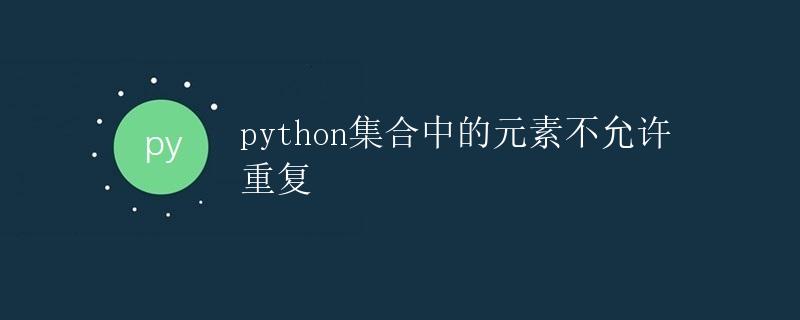Python集合中的元素不允许重复

1. 介绍
在Python编程中,集合(Set)是一种用于存储不重复元素的数据结构。与列表(List)或元组(Tuple)不同,集合中的元素是无序的,且不允许重复。本文将详细介绍Python集合的特性、常见操作以及示例代码。
2. 创建集合
在Python中,可以使用大括号 {} 或者使用内置的 set() 函数来创建集合。
示例代码如下:
# 使用大括号创建集合
fruits = {"apple", "banana", "cherry"}
print(fruits) # 输出: {'apple', 'cherry', 'banana'}
# 使用set()函数创建集合
numbers = set([1, 2, 3, 4, 5])
print(numbers) # 输出: {1, 2, 3, 4, 5}
3. 集合的特性
3.1 无序性:集合中的元素是无序的,即不按照特定的顺序存储和访问元素。
示例代码如下:
fruits = {"apple", "banana", "cherry"}
for fruit in fruits:
print(fruit)
输出可能为:
banana
cherry
apple
3.2 不允许重复:集合中的元素是唯一的,不允许包含重复的元素。如果尝试添加已存在的元素,集合不会做任何改变。
示例代码如下:
fruits = {"apple", "banana", "cherry", "banana"}
print(fruits) # 输出: {'cherry', 'banana', 'apple'}
3.3 可变性:集合是可变的,可以通过添加、删除等操作来修改集合。
示例代码如下:
fruits = {"apple", "banana", "cherry"}
# 添加元素
fruits.add("orange")
print(fruits) # 输出: {'cherry', 'banana', 'apple', 'orange'}
# 删除元素
fruits.remove("banana")
print(fruits) # 输出: {'cherry', 'apple', 'orange'}
4. 集合的常见操作
通过对集合的常见操作,可以实现集合的合并、差集、交集以及判断元素的存在等功能。
4.1 合并集合:使用 union() 或者 | 运算符可以合并多个集合。
示例代码如下:
fruits1 = {"apple", "banana", "cherry"}
fruits2 = {"orange", "kiwi", "apple"}
# 使用union()方法合并集合
merged_fruits = fruits1.union(fruits2)
print(merged_fruits) # 输出: {'banana', 'kiwi', 'apple', 'cherry', 'orange'}
# 使用|运算符合并集合
merged_fruits = fruits1 | fruits2
print(merged_fruits) # 输出: {'banana', 'kiwi', 'apple', 'cherry', 'orange'}
4.2 计算差集:使用 difference() 或者 - 运算符可以计算集合的差集。
示例代码如下:
fruits1 = {"apple", "banana", "cherry"}
fruits2 = {"orange", "kiwi", "apple"}
# 使用difference()方法计算差集
diff_fruits = fruits1.difference(fruits2)
print(diff_fruits) # 输出: {'banana', 'cherry'}
# 使用-运算符计算差集
diff_fruits = fruits1 - fruits2
print(diff_fruits) # 输出: {'banana', 'cherry'}
4.3 计算交集:使用 intersection() 或者 & 运算符可以计算集合的交集。
示例代码如下:
fruits1 = {"apple", "banana", "cherry"}
fruits2 = {"orange", "kiwi", "apple"}
# 使用intersection()方法计算交集
common_fruits = fruits1.intersection(fruits2)
print(common_fruits) # 输出: {'apple'}
# 使用&运算符计算交集
common_fruits = fruits1 & fruits2
print(common_fruits) # 输出: {'apple'}
4.4 判断元素是否存在:可以使用 in 关键字来判断一个元素是否存在于集合中。
示例代码如下:
fruits = {"apple", "banana", "cherry"}
if "apple" in fruits:
print("苹果存在于集合中")
else:
print("苹果不存在于集合中")
输出为:
苹果存在于集合中
5. 总结
本文介绍了Python集合的特性、创建方式以及常见操作。在处理不允许重复元素的情况下,集合是一种非常有用的数据结构。通过合并、差集、交集等操作,可以快速、高效地完成对集合的处理。同时,集合还可以用于判定元素的存在与否。掌握了集合的相关知识,对于解决实际问题中的数据去重、查找等操作将非常方便。
 极客教程
极客教程